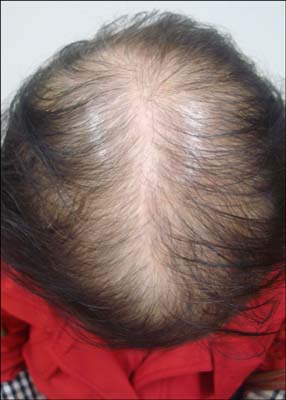Ann Dermatol.
2014 Dec;26(6):743-746. 10.5021/ad.2014.26.6.743.
Pattern Alopecia during Hormonal Anticancer Therapy in Patients with Breast Cancer
- Affiliations
-
- 1Department of Dermatology, Chonbuk National University Medical School, Research Institute of Clinical Medicine, Chonbuk National University-Biomedical Research Institute, Chonbuk National University Hospital, Jeonju, Korea. airmd@jbnu.ac.kr
- KMID: 2264871
- DOI: http://doi.org/10.5021/ad.2014.26.6.743
Abstract
- We report five cases of pattern alopecia in female patients who are undergoing hormonal anticancer therapy for the prevention of recurrence of breast cancer after surgery. Three patients demonstrated male pattern alopecia with receding frontal hairlines, and two patients demonstrated female pattern alopecia without receding hairlines. The detailed clinical history showed that the pattern alopecia of the patients developed after the full recovery of global hair loss of the entire scalp due to previous cytotoxic chemotherapy. All of the adjuvant hormonal anticancer drugs that were used in the patients are antiestrogenic agents, either aromatase inhibitors or selective estrogen receptor modulators. Considering androgen effect on the hair follicles of the fronto-parietal scalp, the androgen-estrogen imbalance caused by the drugs was thought to be the reason for the onset of pattern alopecia in the patients. In general, alopecia that develops during cytotoxic chemotherapy is well known to both physicians and patients; however, the diagnosis of pattern alopecia during hormonal anticancer therapy in breast cancer patients seems to be overlooked.
Keyword
MeSH Terms
Figure
Reference
-
1. Ayoub JP, Valero V, Hortobagyi GN. Tamoxifen-induced female androgenetic alopecia in a patient with breast cancer. Ann Intern Med. 1997; 126:745–746.
Article2. Gateley CA, Bundred NJ. Alopecia and breast disease. BMJ. 1997; 314:481.3. Puglisi F, Aprile G, Sobrero A. Tamoxifen-induced total alopecia. Ann Intern Med. 2001; 134:1154–1155.
Article4. Evrenkaya TR, Atasoyu EM, Unver S, Tulbek MY. Tamoxifen-induced androgenetic alopecia in a dialysis patient with sclerosing encapsulating peritonitis (SEP). Indian J Nephrol. 2004; 14:28–29.5. Carlini P, Di Cosimo S, Ferretti G, Papaldo P, Fabi A, Ruggeri EM, et al. Alopecia in a premenopausal breast cancer woman treated with letrozole and triptorelin. Ann Oncol. 2003; 14:1689–1690.
Article6. Yager JD, Davidson NE. Estrogen carcinogenesis in breast cancer. N Engl J Med. 2006; 354:270–282.
Article7. Tosti A, Pazzaglia M. Drug reactions affecting hair: diagnosis. Dermatol Clin. 2007; 25:223–231.
Article8. Simpson D, Curran MP, Perry CM. Letrozole: a review of its use in postmenopausal women with breast cancer. Drugs. 2004; 64:1213–1230.9. Tulchinsky D, Chopra IJ. Estrogen-androgen imbalance in patients with hirsutism and amenorrhea. J Clin Endocrinol Metab. 1974; 39:164–169.
Article10. Hoffmann R, Niiyama S, Huth A, Kissling S, Happle R. 17alpha-estradiol induces aromatase activity in intact human anagen hair follicles ex vivo. Exp Dermatol. 2002; 11:376–380.
Article11. Shenoy NK, Prabhakar SM. Finasteride and male breast cancer: does the MHRA report show a link? J Cutan Aesthet Surg. 2010; 3:102–105.12. Loube SD, Quirk RA. Breast cancer associated with administration of spironolactone. Lancet. 1975; 1:1428–1429.
Article13. Danielson DA, Jick H, Hunter JR, Stergachis A, Madsen S. Nonestrogenic drugs and breast cancer. Am J Epidemiol. 1982; 116:329–332.
Article



